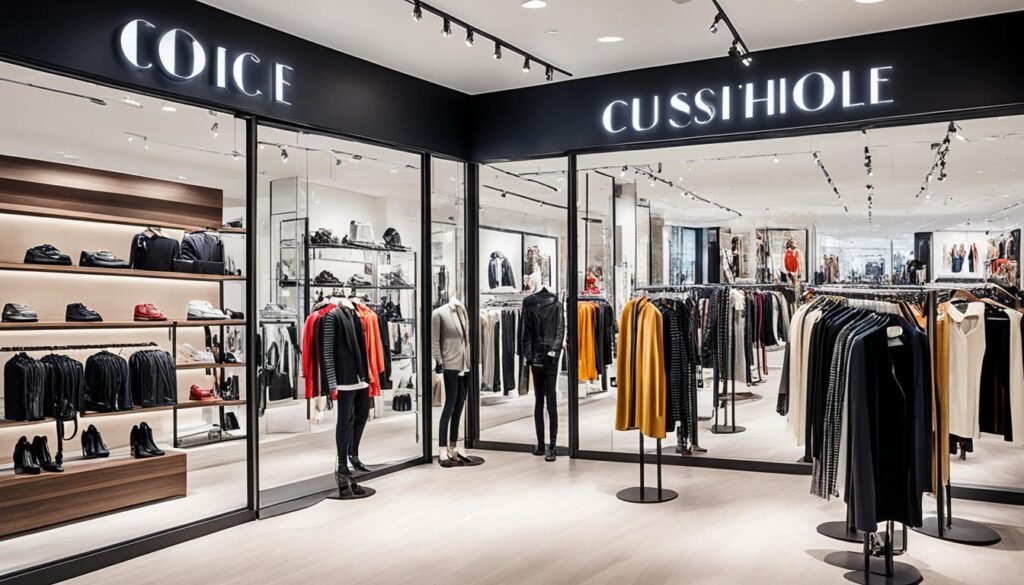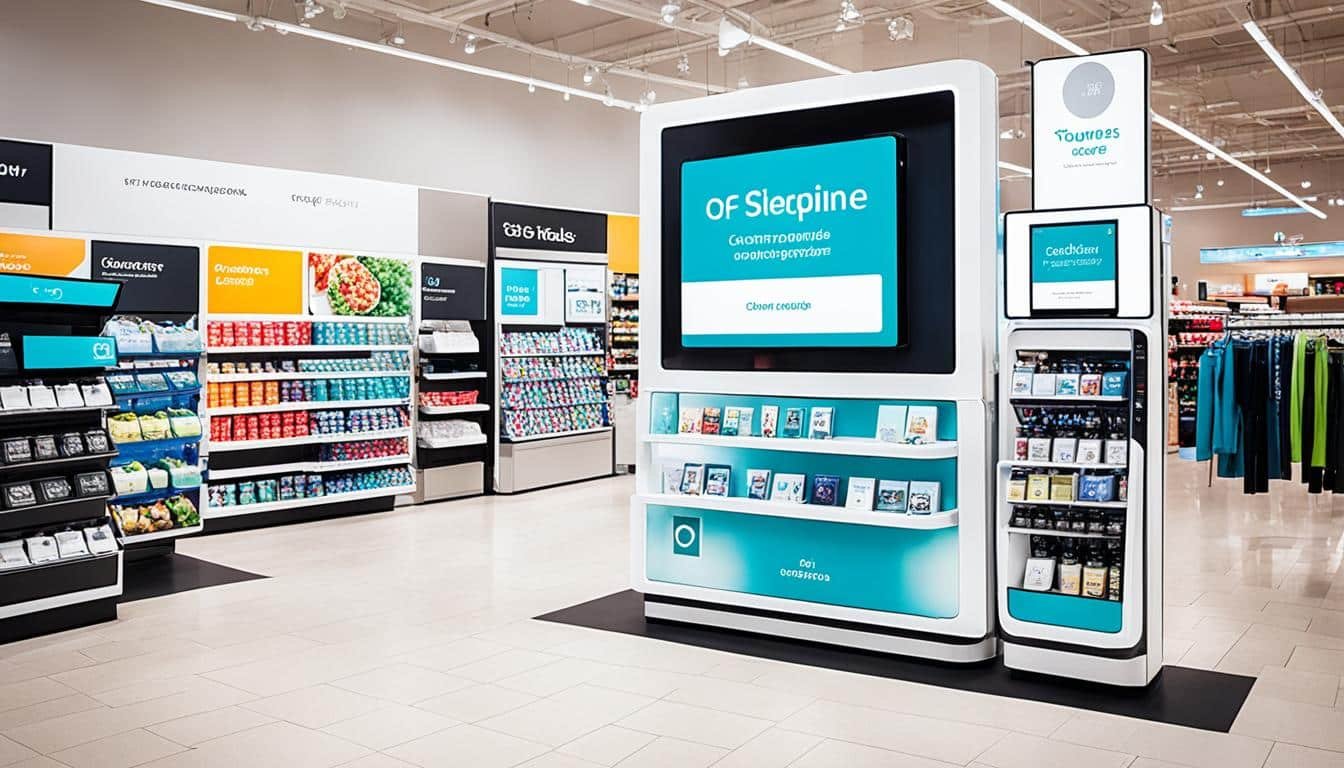Over the past decade, the retail landscape has undergone significant transformations. While e-commerce continues to thrive, offline shopping experiences remain an essential part of the consumer journey. In 2024, several leading brands are making their mark in the realm of brick-and-mortar stores, offering unique in-store experiences that are redefining the way we shop.
In this article, we will explore the top offline shopping stores and the leading brands behind them. These brands have embraced an omnichannel approach, seamlessly blending the best of online and offline worlds to create engaging and personalized in-store experiences, thus captivating the hearts and minds of consumers.
Key Takeaways:
- The retail industry is evolving, with brands combining online and offline channels to cater to consumer preferences.
- Top brands are creating in-store experiences that go beyond traditional shopping, offering immersive and interactive environments.
- Successful brands integrate digital tools and data analytics to enhance the in-store experience and provide personalized recommendations to shoppers.
- The blend of online and offline shopping creates a seamless customer journey, allowing consumers to research online and make purchases in-store.
- Leading brands understand the importance of customer engagement and create unique experiences that leave a lasting impression on consumers, driving loyalty and advocacy.
APL: Combining DTC and Wholesale Channels
APL, a direct-to-consumer brand, has strategically expanded its distribution network by partnering with retailers while maintaining its core DTC business. This innovative approach allows APL to reach a wider consumer audience while leveraging the expertise and established customer base of well-known retailers such as Barney’s, Saks, and Net-a-Porter.
By combining DTC and wholesale channels, APL has unlocked several advantages. Firstly, this partnership strategy enables the brand to tap into the marketing and promotional efforts of its retail partners, generating increased visibility and brand awareness. Additionally, APL gains valuable insights into product demand, market trends, and consumer preferences through its collaborative partnerships.
“Our strategic partnerships with retailers like Lululemon have provided us with invaluable data on product demand and market reception. This information has allowed us to fine-tune our offerings and enhance our marketing strategies.” – APL Executive
Furthermore, APL’s partnership with retailers fosters mutually beneficial marketing initiatives. Collaborative campaigns and cross-promotions strengthen the brand’s presence in both the DTC and wholesale markets, resulting in increased product exposure and demand. This integrated marketing approach ensures that APL remains at the forefront of consumers’ minds, whether they are shopping online or in-store.
Overall, APL’s ability to successfully combine DTC and wholesale channels has proven to be a strategic advantage. This approach allows the brand to meet consumer demands through various touchpoints, capitalizing on different purchasing preferences while expanding its market reach. By embracing both DTC and wholesale partnerships, APL navigates the evolving retail landscape and continues to thrive in a competitive market.
APL’s DTC and Wholesale Expansion Partners:
| Retailer | Partnership Highlights |
|---|---|
| Barney’s | Exclusive collaborations and in-store activations |
| Saks | Strategic pop-up shops and online exclusives |
| Net-a-Porter | Global distribution and curated online collections |
| Lululemon | Data-driven insights, enhanced marketing collaborations |
Image: APL’s iconic sneakers embodying their commitment to style, comfort, and performance.
Casper: From DTC-Only to Wholesale Expansion
Casper, a well-known online mattress brand that initially operated solely through direct-to-consumer (DTC) channels, recognized the potential for growth in the wholesale market. By expanding into the wholesale channel, Casper strategically extended its reach and tapped into the existing customer base of its retail partners, such as Mattress Warehouse and Sam’s Club. This move enabled Casper to cater to a larger consumer audience in the competitive online mattress industry.
The shift from DTC-only to wholesale distribution allowed Casper to leverage the strengths of both channels. While DTC provided the brand with direct control over its marketing and customer experience, partnering with established retailers offered Casper the advantage of wider market visibility and access to a diversified customer base. Through these retail partnerships, Casper solidified its presence in the brick-and-mortar space and provided customers with the opportunity to test and purchase its mattresses in person.
| Retail Partner | Benefits |
|---|---|
| Mattress Warehouse | ● Increased brand exposure in physical stores ● Ability to reach customers who prefer in-store shopping ● Access to a trusted retail partner with an established customer base |
| Sam’s Club | ● Expanded distribution network through a well-known wholesale retailer ● Increased accessibility for customers looking to purchase Casper products in bulk ● Exposure to a broader consumer demographic |
The Impact of Wholesale Expansion on Casper’s Growth
Casper’s foray into the wholesale market has proven to be a significant growth driver for the brand. By diversifying its distribution strategy, Casper has experienced increased market penetration and expanded its consumer reach. This expansion has allowed Casper to compete more effectively with other players in the online mattress industry.
The strategic retail partnerships Casper forged have not only enhanced its brand visibility but also provided valuable insights into consumer preferences and shopping behaviors. Collaborating with established retailers has allowed Casper to gather market data, understand consumer dynamics, and fine-tune its product offerings to meet the evolving needs of customers in the offline retail space.

Success Through DTC-Wholesale Synergy
Through the synergy between its DTC and wholesale channels, Casper has strengthened its market presence and optimized its business operations. By amplifying its distribution capabilities and establishing partnerships with retail giants, Casper has positioned itself as a prominent player within the highly competitive online mattress industry.
As the online mattress industry continues to grow and evolve, Casper’s commitment to innovation and its ability to adapt its business model have contributed to its success. Embracing the advantages of both DTC and wholesale channels has allowed Casper to solidify its market position, ensuring its products are readily accessible to customers across various shopping preferences and touchpoints.
Crocs: Leveraging Both DTC and Wholesale Channels
Crocs, the well-known footwear brand, understands the value of utilizing both direct-to-consumer (DTC) and wholesale channels to effectively reach a diverse consumer audience. By maintaining a balanced distribution model, Crocs ensures that 50% of their business comes from wholesale partnerships while the other 50% is generated through their DTC efforts. This strategic approach allows the brand to maximize its market reach and cater to a wide range of customer preferences.
In leveraging DTC, Crocs can establish a direct connection with consumers, providing them with unique shopping experiences and tailored messaging. This approach allows the brand to showcase its extensive product range and highlight its commitment to comfort, style, and innovation. Through their DTC channels, Crocs can also gather valuable customer data, enabling them to continuously improve their offerings and meet the evolving demands of the market.
Simultaneously, Crocs understands the importance of nurturing retail partnerships to tap into existing distribution networks and expand their global footprint. By collaborating with well-established retailers, the brand gains access to diverse customer demographics and leverages the established customer base and market expertise of their partners. Crocs’ retail partnerships enable them to reach consumers who may not have been introduced to their brand through other means, further boosting their visibility and sales.
The international market presents significant growth opportunities for Crocs. With their iconic and versatile footwear, Crocs has gained immense popularity and a strong consumer following in various global regions. The brand’s presence in the international market is expected to flourish, especially as they continue to forge new retail partnerships and adapt their strategies to suit the preferences of different cultures and markets.
Crocs’ success in both the DTC and wholesale domains can be attributed to their commitment to delivering quality products and seamless shopping experiences. Their ability to strike a balance between these channels has proven effective in achieving widespread brand awareness and customer satisfaction. By capitalizing on the strengths and advantages of both DTC and wholesale, Crocs positions itself as a dominant player in the footwear industry.

Key statistics:
| Key Metric | Value |
|---|---|
| Percentage of Business from Wholesale | 50% |
| Percentage of Business from DTC | 50% |
| Projected Growth in International Market | High |
Crocs’ commitment to hybrid retail strategies sets them apart in the industry, allowing them to effectively serve a wide consumer base while capitalizing on the unique advantages of each channel. By embracing DTC and establishing strong retail partnerships, Crocs positions itself for continued success and growth in both the domestic and international markets.
Purple: Challenges and Opportunities in Offline Retail
Purple, a mattress brand, recognizes the challenges and opportunities that come with their offline retail strategy. While some stores in their store fleet may be less profitable than others, the brand remains optimistic about reaching profitability and adapting to changing consumer behavior.
Adapting to changing consumer behavior is essential in the ever-evolving retail industry, and Purple understands the importance of staying ahead of the curve. By closely monitoring consumer behavior and trends, the brand can tailor its offline retail strategy to meet the needs and preferences of its target audience.
One of the challenges Purple faces in their offline retail strategy is ensuring the profitability of all their stores. As with any retail business, certain locations may be more challenging in terms of foot traffic and sales. However, the brand is committed to continuously improving its store fleet to maximize profitability.
“We believe that offline retail still has a significant role to play in the overall customer journey. While online channels provide convenience and accessibility, the in-store experience allows customers to physically interact with our products and truly understand the Purple difference.”
Understanding consumer behavior is crucial for Purple’s offline retail success. By leveraging consumer insights and data analytics, the brand can make informed decisions regarding store locations, layout, and product assortment. This data-driven approach enables Purple to optimize its offline retail strategy and provide a seamless shopping experience for customers.
Purple is committed to continuously improving its core business and achieving consistent growth in the offline retail space. While the challenges are evident, the brand sees them as opportunities for innovation and adaptation. By staying agile and responsive to consumer demands, Purple aims to establish a strong presence in the offline retail market.
As Purple navigates the challenges and opportunities in offline retail, the brand remains focused on its mission to provide customers with an unmatched sleep experience. By delivering high-quality products and exceptional customer service, Purple aims to become a trusted name in both online and offline retail.

Glossier: Building a Long-lasting Brand
Glossier, a beauty brand, has established itself as a disruptive force in the industry by seamlessly integrating content and commerce through their influential blog, Into the Gloss. Over the past 10 years, Glossier has built a strong and loyal community, setting a benchmark for other brands to follow in terms of engagement and brand loyalty.
Glossier’s approach to building a long-lasting brand goes beyond simply selling products. They have successfully created a community around their brand, fostering a sense of belonging and connection among their customers. This community-centric approach has been instrumental in Glossier’s continued growth and success.
Disruptive Brand
Glossier is not your typical beauty brand. They have disrupted the industry with a fresh and relatable approach that resonates with today’s consumers. From their inclusive marketing campaigns to their minimalist product designs, Glossier has carved out a distinct identity that sets them apart from traditional beauty brands.
By tapping into the power of social media and influencer marketing, Glossier has created a buzz around their products, generating a high level of anticipation and demand. Their products have become highly coveted, with customers eagerly waiting for new releases and restocks.
Community Building
Glossier understands the importance of building a community and empowering their customers to become brand advocates. Through their active presence on social media platforms like Instagram, Glossier encourages customers to share their experiences and create a sense of community around the brand.
Customers not only feel a connection to the products but also to the Glossier brand as a whole. Glossier’s strong community engagement has resulted in a loyal customer base that actively promotes the brand to their networks, further expanding Glossier’s reach and influence.
Content and Commerce Integration
One of the key strategies that have contributed to Glossier’s success is their seamless integration of content and commerce. Through their blog, Into the Gloss, Glossier creates valuable and engaging content that educates and inspires their audience.
By sharing beauty tips, interviews with industry experts, and behind-the-scenes insights, Glossier not only builds credibility but also establishes themselves as a trusted source of information within the beauty community. This content serves as a natural introduction to Glossier’s products, driving traffic to their e-commerce platform.
The integration of content and commerce allows Glossier to provide a holistic shopping experience for their customers. By combining educational and entertaining content with a seamless shopping journey, Glossier effectively guides their audience throughout the customer journey, from awareness to purchase.

Glossier’s commitment to building a long-lasting brand is evident in their disruptive approach, community-building efforts, and integration of content and commerce. By fostering a strong sense of community and delivering a unique shopping experience, Glossier has solidified its position as a leader in the beauty industry.
Lovesac: Designing Products for Life
Lovesac, a direct-to-consumer brand, is revolutionizing the furniture industry with its customizable and adaptable products. The brand’s innovative sactional setup allows customers to personalize their furniture according to their individual needs and preferences. From adding extra seats for hosting large gatherings to changing the upholstery for a fresh look, Lovesac provides a versatile and long-lasting solution for any living space.
With a focus on durability and flexibility, Lovesac ensures that customers can enjoy their furniture for years without the need for frequent replacements. The brand’s commitment to high-quality materials and craftsmanship sets it apart from competitors, allowing them to create products that can withstand the test of time. By designing products for life, Lovesac delivers on its promise of providing furniture that lasts.
Modular Customization
The key to Lovesac’s success lies in its modular approach to furniture design. Customers can start with a basic configuration and easily add or remove components to create the perfect setup for their living space. Whether it’s rearranging the seats, changing the armrests, or modifying the configuration, Lovesac offers endless possibilities to suit any style or layout.
This direct-to-consumer brand understands the importance of catering to individual needs and preferences. By offering a wide range of fabric options, colors, and accessories, Lovesac ensures that customers can truly make their furniture their own. This level of customization enhances the overall buying experience and creates a sense of ownership and personal connection with the product.
Return on Ad Spend
As a direct-to-consumer brand, Lovesac focuses on digital marketing strategies to reach its target audience and drive sales. The company has invested heavily in online advertising, leveraging social media platforms and search engines to connect with potential customers. Through targeted campaigns and strategic placement, Lovesac has achieved a high return on ad spend, maximizing the effectiveness of their marketing efforts.
The brand’s commitment to customer satisfaction and product quality translates into positive reviews and word-of-mouth referrals. Lovesac’s loyal customer base has become its best advocate, spreading the word about the brand’s unique offerings and exceptional customer service. This organic growth, coupled with efficient digital marketing strategies, has resulted in a strong return on investment for Lovesac.

| Benefits of Lovesac’s Sactional Setup | Enhanced Durability | Flexibility and Adaptability |
|---|---|---|
| Customizable and adaptable furniture | Constructed with high-quality materials | Easily change configurations over time |
| Wide range of fabric options and colors | Built to withstand daily use | Add or remove components as needed |
| Creates a personalized and unique living space | Designed for long-lasting performance | Can be modified to suit any style or layout |
On: Performance, Design, and Sustainability
When it comes to performance footwear, On is a brand that stands out. Renowned for their innovative products, they have successfully combined the elements of performance, design, and sustainability in their footwear range. Catering to both athletes and lifestyle customers, On has expanded their offerings to include new sports and categories, making their brand accessible to a wider consumer audience.
Product Innovation
One of the key strengths of On is their commitment to product innovation. Their team of experts continuously pushes the boundaries of footwear design, incorporating cutting-edge technologies to enhance performance. Whether it’s their patented CloudTec cushioning system or their precision-engineered midsoles, On’s commitment to innovation ensures that their customers receive the best possible products.
Also Read:- Mastering Black Friday Shopping With Strategic Techniques
Company Vision
On’s company vision focuses on long-term sustainability. They strongly believe in creating products that not only perform well but also have a positive impact on the environment. By incorporating sustainable materials and manufacturing processes into their production, On is paving the way for a more eco-friendly future in the performance footwear industry.
“At On, we envision a world where performance and sustainability go hand in hand. We are dedicated to creating products that not only help athletes excel but also minimize our environmental impact.”
Lifestyle Customers
While On is a go-to brand for athletes, they also cater to lifestyle customers who value both style and comfort. Their footwear designs seamlessly merge performance features with fashionable aesthetics, allowing customers to effortlessly transition from a workout session to everyday activities without compromising on style. On’s ability to cater to the needs of both athletes and lifestyle enthusiasts is a testament to their versatility and customer-centric approach.
| Key Features: | On Performance Footwear |
|---|---|
| Performance | Advanced technologies for optimal performance |
| Design | Sleek and stylish footwear for athletes and lifestyle customers |
| Sustainability | Incorporation of sustainable materials and practices |
In conclusion, On has established itself as a leading brand in the performance footwear industry by offering products that excel in performance, design, and sustainability. Their commitment to innovation and their vision for a more sustainable future sets them apart from the competition. From athletes seeking top-notch gear to lifestyle customers looking for stylish and comfortable footwear, On caters to a diverse range of customers with their versatile and high-quality products.
Conclusion
The retail industry is undergoing significant changes as brands adapt to the evolving preferences of consumers. In response to the growing popularity of online shopping, many brands are combining offline and online channels to create a seamless omnichannel shopping experience.
Direct-to-consumer (DTC) brands have recognized the value of partnering with retailers to expand their reach and leverage established distribution networks. At the same time, traditional retail brands are expanding their DTC presence to establish a direct connection with consumers.
In this dynamic landscape, offline shopping remains a crucial aspect of the retail industry. Bricks-and-mortar stores provide an immersive and personal shopping experience that online channels cannot replicate. Successful brands are incorporating digital tools and data analytics to enhance the in-store experience, personalize customer interactions, and optimize product assortments.
As the retail industry continues to evolve, it is essential for brands to stay ahead of offline shopping trends and embrace omnichannel strategies. By understanding and responding to consumer preferences, brands can build lasting relationships and create seamless shopping experiences that bridge the gap between online and offline channels.
FAQs
Q: What are brick-and-mortar stores?
A: Brick-and-mortar stores refer to physical retail locations where customers can visit in-person to make purchases, as opposed to online shopping.
Q: What is the significance of leading retail stores in 2024?
A: Leading retail stores in 2024 play a vital role in the offline shopping industry by offering a diverse range of products to customers through in-store experiences.
Q: How do retailer brands adapt to digital transformation?
A: Retailer brands adapt to digital transformation by integrating online platforms with their brick-and-mortar stores to provide customers with various shopping options.
Q: What is the impact of 2023 trends on offline retail stores?
A: The 2023 trends have influenced offline retail stores to enhance their customer experience, online presence, and supply chain management to stay competitive in the market.
Q: How do in-store retail experiences differ from online shopping?
A: In-store retail experiences offer customers the advantage of physically touching and trying products before making a purchase, providing a more personalized shopping experience compared to online shopping.
Q: Which leading brands are known for their offline stores presence in 2024?
A: Brands such as Best Buy, Costco, and fashion brands like Farfetch have established a strong offline store presence in 2024 to cater to customers’ preferences for in-person shopping.
Q: How do offline businesses stay competitive against online platforms?
A: Offline businesses stay competitive against online platforms by focusing on unique in-store experiences, exclusive offers, and personalized services that online shopping cannot match.





